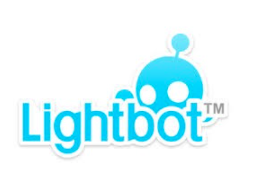
Lightbot Coding

Overview
Coding or programming is the way that we as programmers, can tell a computer what to do using instructions that the computer will understand. The instruction for coding can be either in words or icons. Lightbot is a programming puzzle game.
Lightbot teaches;
- Sequence: Commands that are executed one right after the other
- Procedures: Blocks of code using patterns
- Loops: Blocks of code using patterns that repeat
- Debugging: Running and re-running a program, testing the solutions, and correcting errors
Learning Objectives
Students will:
-
Be able to plan out a series of instructions for the robot.
-
Be able to write a program by having Lightbot run through instructions programmed by them.
-
Be able to test if the end result of the program was correct (all blue tiles were lit).
-
Be able to debug if the result was incorrect, find the error, and modify the program to test again.
Vocabulary
Vocabulary Words:
- Algorithm: An algorithm is a series of instructions on how to accomplish a task.
- Coding: Coding is transforming actions into a symbolic language.
- Debugging: Debugging is finding and fixing issues in code.
- Function: Function is a piece of code that can be called over and over.
- Parameters: Parameters are extra bits of information that you can pass into a function to customize it.
- Loop: A loop is an act of doing something over and over again.
- Variable: A variable is a placeholder for a piece of information that can change.
- Command: A command is an instruction for the computer. Many commands put together make up algorithms and computer programs.
Pre-planning
To prepare for this lesson:
- Watch the video “How to Use the Coding Apps Lightbot Jr. and Lightbot.”
- Download Lightbot on your mobile device from Google Play or iTunes.
- Print out the Teacher Solutions for Lightbot.
Accommodations
See Accommodations Page and Charts on the 21things4students.net site in the Teacher Resources.
Steps
Directions for this activity:
-
Explain that the Lightbot is a coding program.
-
Review the coding vocabulary.
-
Explain that artificial intelligence (the Lightbot) is hard to program and that not every bot can maneuver and function on its own. However, some bots can follow along a path that the programmer creates for them in order to solve the puzzle. Their job is to light up all the blue tiles by the commands you issue.
-
Have students watch the video as an introduction
-
Introduce the Lightbot to students
-
Show students the commands and how to drag and drop the commands in the basic level one.
-
Display the Lightbot and have students follow along as you explain procedures in basic for solving the puzzle and lighting up the tiles. There are eight levels in basic. Model as many as needed depending on the level of the students.
-
Explain that it is okay to find and fix commands if the solution doesn’t work the first or second time.
-
Have students try Lightbot on their own and advance at their own pace. Once the Basic Level is completed move onto Procedures two and Loops three.
Assessment Options
Different options for assessing the students:
- Observations
- Check for understanding
- Students advance at their own level
MITECS Competencies & ISTE Standards
MITECS: Michigan adopted the "ISTE Standards for Students" called MITECS (Michigan Integrated Technology Competencies for Students) in 2018.
Computational Thinker
5a. Students formulate problem definitions suited for technology-assisted methods such as data analysis, abstract models and algorithmic thinking in exploring and finding solutions.
5b. Students collect data or identify relevant data sets, use digital tools to analyze them, and represent data in various ways to facilitate problem-solving and decision-making.
5d. Students understand how automation works and use algorithmic thinking to develop a sequence of steps to create and test automated solutions.
Devices and Resources
Mobile Device
App, Extension, or Add-on:
Lightbot can be found in the Apple, Amazon and Google Play Stores
Websites:
How to Use the Coding Apps
CONTENT AREA RESOURCES
ELA
Students will write out commands and how they problem solved the solutions.
Math
Students will learn basic programing skills.
Students are learning sequence and problem solving.
CREDITS
This task card was created by Sue Prusik, New Haven Community Schools, June 2020.


